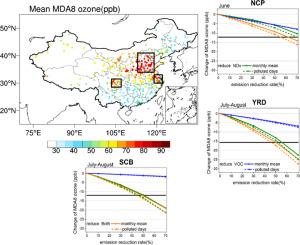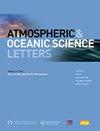Implications of the extremely hot summer of 2022 on urban ozone control in China
IF 3.2
4区 地球科学
Q3 METEOROLOGY & ATMOSPHERIC SCIENCES
引用次数: 0
Abstract
Frequent occurrences of extreme heat are causing severe ozone pollution over China. This study examined the driving factors of urban ozone pollution in China during the extremely hot summer of 2022 and the impact of emission control strategies using surface measurements and the GEOS-Chem model. The results show that ozone pollution was extremely severe in summer 2022, with a significant rebound by 12–15 ppbv in the North China Plain (NCP), Yangtze River Delta (YRD), and Sichuan basin (SCB), compared to 2021. Especially over the NCP, the MDA8 (maximum daily 8-hourly average) ozone exceeded 160 ppbv, and the number of ozone exceedances was over 42 days. Based on an IPR (integrated process rate) analysis, the authors found that the net chemical production was the dominant factor contributing to the strong ozone increase in summer 2022. For example, in June over the NCP, the net chemical production resulted in an increase by 3.08 Gg d−1 (∼270%) in ozone mass change. Sensitivity simulations showed that both NOx (nitrogen oxides) and VOC (volatile organic compound) reductions were important over the NCP, and NOx reductions were more important than VOCs over southern China. To keep the ozone of 2022 at the same level as 2021, a joint reduction of NOx and VOCs by at least 50%–60% would have been required. This study highlights the urgency to develop effective ozone management since extreme heat will become more frequent.
摘要
本文利用地面观测和数值模式研究了2022年夏季极端高温下我国城市臭氧污染的控制策略. 研究表明, 2022年夏季臭氧污染极为严重, 相较于2021年有显著的反弹, 其中华北, 长三角和四川盆地的月均臭氧上升12–15 ppbv. 模式过程分析结果表明净化学生产是高温时造成臭氧浓度升高的主导因素. 模式多组敏感性试验表明, 华北地区需要NOx和VOC协同控制, 南方城市需要侧重对NOx排放管控, 并且需要对NOx和VOC协同减排至少50%–60% 才会使2022年夏季臭氧污染水平与2021年一致. 在极端高温愈发频繁的形势下, 本研究强调未来亟需研究更为有效的臭氧调控策略.

2022 年酷暑对中国城市臭氧控制的影响
频繁出现的极端高温导致中国上空臭氧污染严重。本研究利用地面测量数据和 GEOS-Chem 模型,研究了 2022 年酷暑期间中国城市臭氧污染的驱动因素以及排放控制策略的影响。结果表明,2022 年夏季臭氧污染极为严重,与 2021 年相比,华北平原、长江三角洲和四川盆地的臭氧污染显著反弹了 12-15 ppbv。特别是在华北平原,MDA8(最大日 8 小时平均值)臭氧超过 160 ppbv,臭氧超标天数超过 42 天。根据 IPR(综合过程率)分析,作者发现净化学生产是导致 2022 年夏季臭氧剧增的主要因素。例如,6 月份在国家臭氧中心上空,净化学生产导致臭氧质量变化增加了 3.08 Gg d-1(∼270%)。敏感性模拟结果表明,氮氧化物(NOx)和挥发性有机化合物(VOC)的减少在国家臭氧方案中都很重要,而在华南地区,氮氧化物的减少比挥发性有机化合物更重要。要将 2022 年的臭氧保持在与 2021 年相同的水平上,需要将氮氧化物和挥发性有机化合物共同减少至少 50%-60%。摘要本文利用地面观测和数值模式研究了 2022 年夏季极端高温下我国城市臭氧污染的控制策略。研究表明,2022 年夏季臭氧污染极为严重,相较于 2021 年有显著的反弹,其中华北、长三角和四川盆地的月均臭氧上升 12-15 ppbv。模式过程分析结果表明净化学生产是高温时造成臭氧浓度升高的主导因素。多组敏感性试验表明, 华北地区需要对 NOx 和 VOC 协同控制, 南方城市需要侧重对 NOx 排放管控, 并且需要对 NOx 和 VOC 协同减排至少 50%-60% 才会使 2022 年夏季臭氧污染水平与 2021 年一致。在极端高温愈发频繁的形势下,本研究强调未来亟需研究更为有效的臭氧调控策略。
本文章由计算机程序翻译,如有差异,请以英文原文为准。
求助全文
约1分钟内获得全文
求助全文
来源期刊

Atmospheric and Oceanic Science Letters
METEOROLOGY & ATMOSPHERIC SCIENCES-
CiteScore
4.20
自引率
8.70%
发文量
925
审稿时长
12 weeks
 求助内容:
求助内容: 应助结果提醒方式:
应助结果提醒方式:


